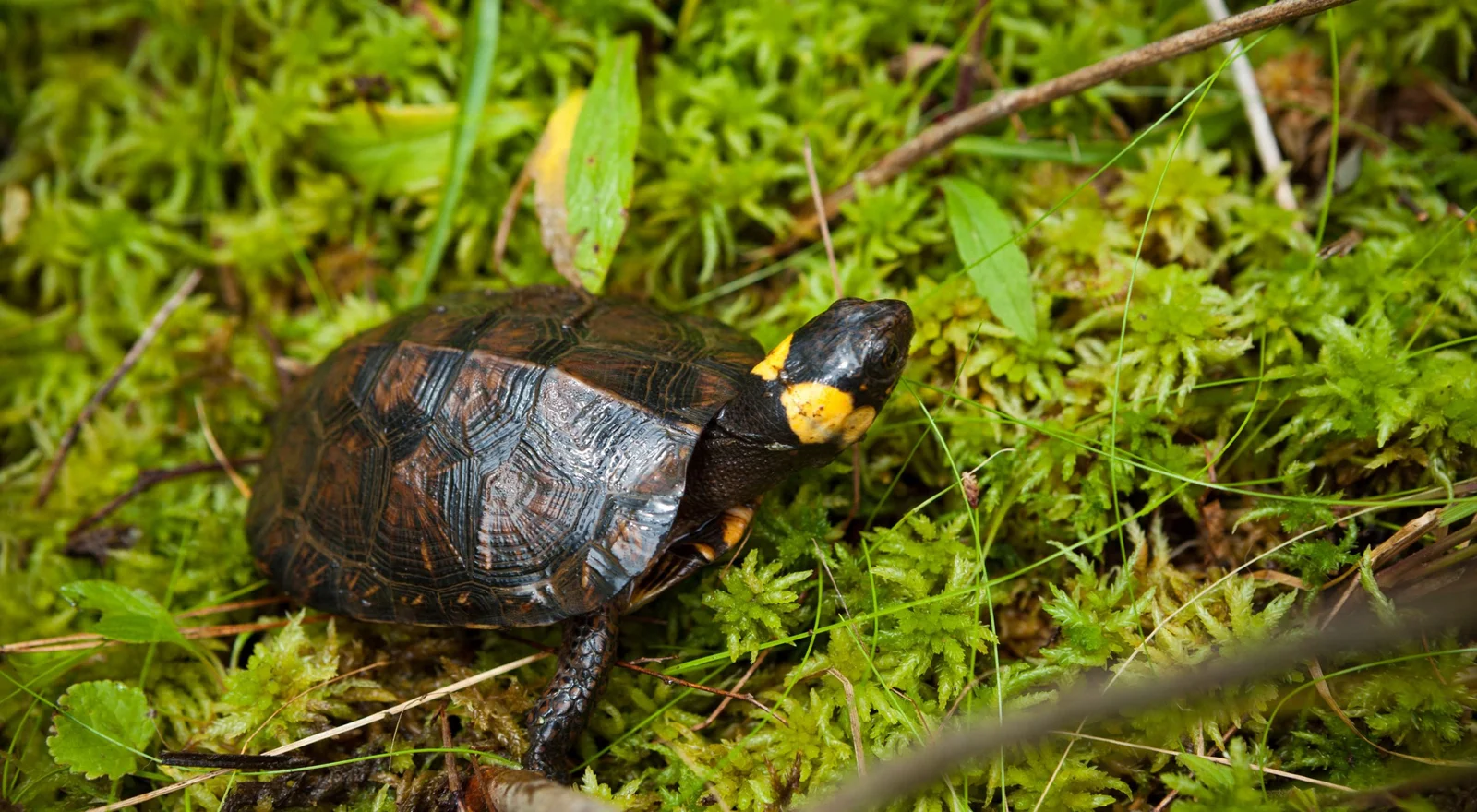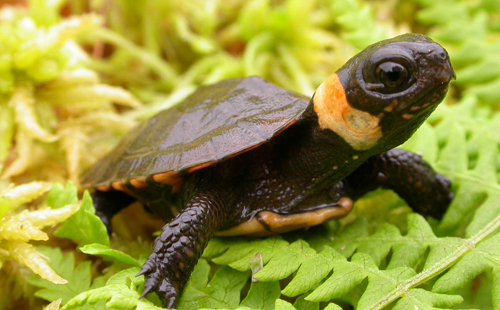Why is the Bog Turtle Endangered

The Bog Turtle is one of the most endangered turtles in North America. There are only about 500 adult Bog Turtles remaining in the wild, and their populations are continuing to decline. The primary reason for their decline is habitat loss and fragmentation.
Bog Turtles rely on specific habitat conditions in order to survive, and as these habitats disappear, so do the Bog Turtles. Additionally, Bog Turtles are often collected by illegal wildlife traffickers and sold on the black market. In order to save this species from extinction, we must work to protect their remaining habitats and crack down on wildlife trafficking.
The Bog Turtle is a small, threatened turtle that is found in the northeastern United States. It gets its name from the bogs and fens where it lives. The Bog Turtle is endangered because of habitat loss and fragmentation.
As development increases in areas where Bog Turtles live, their habitats are destroyed or fragmented. This makes it difficult for them to find food and mates, and increases their risk of being killed by predators.
Saving the Bog Turtle, One of the Rarest Kinds in North America
Why is the Bog Turtle Important
The bog turtle is a small, semi-aquatic turtle that is found in the northeastern United States and southeastern Canada. It is one of the most endangered turtles in North America and is protected under the Endangered Species Act.There are several reasons why the bog turtle is important.
First, it is an indicator species for healthy wetlands. This means that if bog turtles are present in an area, it is likely that the wetland is healthy and functioning properly. Bog turtles also play an important role in controlling insect populations.
Their diet consists mostly of insects, which helps to keep these populations in check.Finally, bog turtles are simply unique and beautiful creatures that deserve our protection. They have been on this planet for millions of years and play an important role in the ecosystem.
We need to do everything we can to ensure their survival into the future.
Bog Turtle Population
The Bog Turtle is a small, semi-aquatic turtle that is found in the eastern United States. The turtle gets its name from the fact that it often inhabits bogs and other wetlands. The Bog Turtle is listed as a threatened species by the US Fish and Wildlife Service.
The main threat to the turtles is habitat loss due to development and agriculture.There are an estimated 4,000-5,000 Bog Turtles left in the wild. The majority of these turtles are found in New Jersey, Pennsylvania, Virginia, and West Virginia.
In recent years, there has been some success in increasing the population of Bog Turtles through captive breeding and release programs.The best way to help protect Bog Turtles is to conserve their wetland habitats. This can be done by working with landowners to create or maintain wetlands on their property.
Bog Turtle Status
The Bog Turtle is a small, elusive turtle that lives in bogs and other wetland habitats in the Northeastern United States. Listed as a federally threatened species since 1997, the Bog Turtle is one of the most endangered turtles in North America. An estimated 5,000 to 10,000 Bog Turtles remain in the wild, making it one of the rarest turtles on Earth.
The primary threat to Bog Turtles is habitat loss and fragmentation due to development and land-use change. As humans encroach on their wetland habitats, these turtles are forced into smaller and smaller areas where they are more vulnerable to predation and disease. In addition, Bog Turtles are popular pets among reptile collectors, further adding to their decline.
Despite its listing as a federal threatened species, there are currently no regulations in place specifically protecting Bog Turtles or their habitats. This means that developers can still build on or destroy wetlands where these turtles live with little consequence. Conservation groups are working to raise awareness about this unique and imperiled species in hopes of securing better protection for them before it’s too late.
Bog Turtle Habitat
There are many different types of turtles that can be found all over the world. Bog turtles are a type of turtle that is native to North America. They get their name from the habitats they typically live in, which are wetland areas with lots of vegetation, like bogs and fens.
Bog turtles are small turtles, with adults only reaching about 4-6 inches in length. Their shells are dark brown or black and have yellow stripes running down the sides.Bog turtles spend most of their time in or near water, but they will also bask on land in sunny areas.
During the winter months, they hibernate underground. Bog turtles typically eat insects and other small invertebrates. They will also eat some plant matter if it is available.
Bog turtles face many threats to their survival including habitat loss, being collected for the pet trade, and being hit by cars when they cross roads. Because of these threats, bog turtles are considered a threatened species in many states where they live. If you see a bog turtle while out hiking or camping, leave it alone!
Enjoy watching it from a distance instead so that you don’t disturb its natural habitat.

Credit: www.endangered.org
How Many Bog Turtles are Left in the World?
There are an estimated 5,000-8,000 bog turtles left in the wild. Bog turtles are a small species of turtle that is found in the northeastern United States and southeastern Canada. They get their name from the fact that they often live in bogs and other wetland habitats.
Bog turtles are listed as a threatened species under the US Endangered Species Act. The main threats to bog turtles are habitat loss and degradation.
When Did Bog Turtles Become Endangered?
Bog turtles (Glyptemys muhlenbergii) are a small North American turtle species. They are one of the most endangered turtles in the world, with a population estimated at just over 1,000 adult individuals in the wild. Bog turtles were first listed as an endangered species in 1997, and their status has not changed since then.
The primary threat to bog turtles is habitat loss and fragmentation due to development and other land-use changes. In addition, bog turtles are often collected by poachers for the pet trade. Conservation efforts for this species include protecting and restoring bog turtle habitat, educating people about the importance of keeping these turtles wild, and law enforcement against poachers.
Where are Bog Turtles Endangered?
Bog turtles are endangered throughout their range, which extends from southern New England to northern Georgia. The primary reason for this decline is habitat loss and fragmentation due to development, agriculture, and other land uses. Bog turtles require specific habitat conditions in order to survive, including wetland areas with soft, spongy soils and an abundance of aquatic plants.
These conditions are becoming increasingly rare as natural wetlands are replaced by man-made ones that do not provide the same habitat quality. In addition to habitat loss, bog turtles are also threatened by illegal collecting for the pet trade and by mortality on roads.
What are the main threats to the Hawksbill Turtle’s endangerment?
The hawksbill turtle population decline is primarily threatened by habitat loss and degradation, as well as illegal trade and poaching. Climate change, pollution, and accidental capture in fishing gear also contribute to their endangerment. Conservation efforts, including habitat protection, anti-poaching measures, and sustainable fishing practices, are crucial to saving this critically endangered species.
What are the Threats to the Bog Turtle?
There are several threats to bog turtles. The biggest threat is habitat loss due to development, agriculture, and forestry practices. Bog turtles need both wet and dry areas within their habitat, and these areas are often lost when development occurs.
Other threats include predators (including humans), road mortality, and disease. Climate change may also pose a threat to bog turtles in the future as it alters the moisture levels in their habitats.
Conclusion
The bog turtle is a small, threatened species of turtle that is found in the northeastern United States and southeastern Canada. The bog turtle is endangered due to habitat loss, collection for the pet trade, and predation by introduced species such as raccoons. Bog turtles are also impacted by changes in water quality and quantity due to human activities such as agriculture and development.